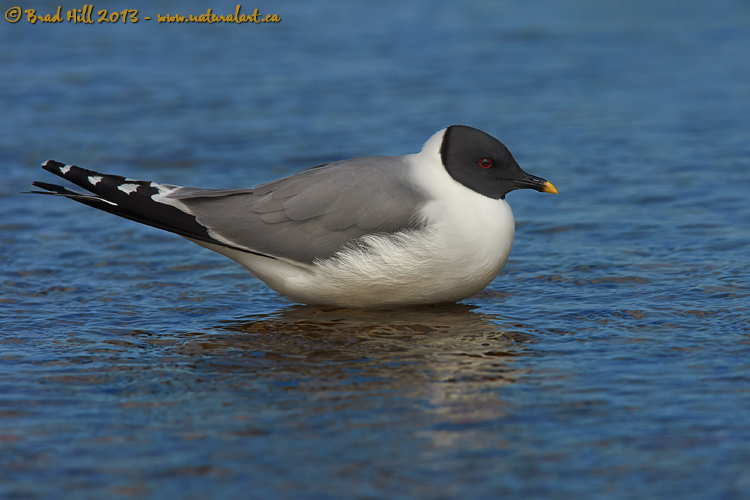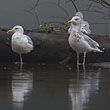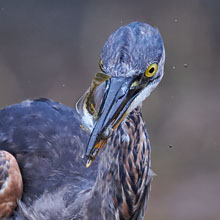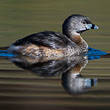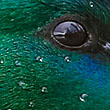Availability: Undetermined - Enquiries?
In the Field
Sabine's Gull - Just Being. Victoria Island, Nunavut, Canada. June 29, 2013.
When natural selection shaped - or God made (take your pick!) - the Sabine's Gull, it or he/she did something very right. While beauty is in the eye of the beholder, few would argue that this unique and distinctive gull isn't exceptionally eye-catching. And it's all done with shades of gray and just a small touch of colour (that's so tastefully applied!). In this shot its slate-gray head (exquisitely ringed in a black collar), yellow-tipped bill, blood-red eye-ring all are visible. What's not visible on this shot is this small gull's striking wing pattern that's seen in all plumages of the bird - the dramatic wing pattern may be seen in this flight shot...
The Sabine's Gull is a small gull about the size of the more familiar Bonaparte's Gull. It breeds only in the high arctic - which means relatively few have seen it in the full splendor of its breeding plumage. The Sabine's Gull doesn't fit the gull "mold" very well - in some way it acts more like a tern than a gull (both in its flight and foraging behaviour), and some aspects of its behaviour - like its penchant for rapidly running on dry ground - are more like a shorebird than any other gull. Even its migration pattern is odd - it nests in the arctic (of Canada and Eurasia) and then part of the population travels all the way down the western coast of the Americas to overwinter off South America. The other part? It boogies down to the western coast of southern Africa. Where within northern Canada does the line of demarcation separating the South American migrators from the South African migrators occur? No one knows. So this bird may have a Latino accent or a South African one!
I rarely shoot simple "documentary images" of wildlife (many know I refer to them as "of a" images - you know...the type where comments about them always include the phrase "of a" - as in "oh...that's a nice image of a bear" - as opposed to simply "my...what a beautiful photo"). In my mind, if the viewer has to include "of a" when describing an image of mine, I've failed in my mission of creating natural art! Anyway...once in a while the subject - like this Sabine's Gull - is so beautiful in and of itself that I can relax a little and just take an "of a" picture of it and it's still is darned eye-catching. Thanks Ma Nature.
Capturing this image wasn't too tough - the hard part was really just finding the subject in breeding plumage. I did have to lay down on my back (on large angular rocks!) and shoot between my legs (while balancing a fairly heavy lens) to get the low angle shown here...but I never expected wildlife photography to be "comfortable" when I got into it! Of course, getting the exposure just right during capture - which in this case meant retaining all the highlights, but JUST retaining them - was critical. And, getting the light just right during raw conversion was equally critical - that head was VERY dark (but not quite black - except on the collar) and that plumage on the back of the head, neck and breast was VERY white. So - at the end of the day even this simple "of a" shot of a Sabine's Gull took a surprising amount of work!
This is one of those images that pretty much needs to be seen in a large version to be appreciated - so here's a 2400 pixel version of it:
• Sabine's Gull - Just Being: Download 2400 pixel image (JPEG: 829 KB)
NOTE: This image is protected by copyright - I'm fine with personal uses of it, but unauthorized commercial use of the image is prohibited by law. Thanks in advance for respecting my copyright!
Behind the Camera
Sabine's Gull - Just Being. Victoria Island, Nunavut, Canada. June 29, 2013.
Digital Capture; Compressed RAW (NEF) format; ISO 500.
Nikon D4 paired with Nikkor 400mm f2.8 VR with TC-14EII (1.4x) teleconverter (550mm total focal length). Hand-held. VR on and in normal mode.
1/1250s @ f11; -0.67 stop compensation from matrix-metered exposure setting.
At the Computer
Sabine's Gull - Just Being. Victoria Island, Nunavut, Canada. June 29, 2013.
RAW Conversion to 16-bit TIFF, including first-pass/capture sharpening using Capture One Pro version 7. Four raw variants (images processed from raw) differing by a total of 2 stops in total exposure.
Further digital corrections on resulting 16-bit TIFF files using Adobe's Photoshop CC and Light Craft's LightZone. Photoshop adjustments included compositing/blending the four exposure variants, very minor colour tweaks (hue rotation and desaturation of selected colours), further selective exposure tweaks and selective contrast adjustment, and selective sharpening for web output. Final tone tweaking performed using tonemapper/re-light tool in Lightzone.
Conservation
Sabine's Gull - Just Being. Victoria Island, Nunavut, Canada. June 29, 2013.
Ten percent of the revenue generated by this image will be donated to Raincoast.
Species Status in Canada*: Not considered at risk in the immediate future.
The Sabine's Gull (Xema sabini) is a very unusual and highly-distinctive arctic gull that breeds only on tundra in high latitudes. This species is considered to be an aberrant gull, both physically and in its behaviour. It is only one of two gulls with a black bill with yellow tip. And, on the behavioural side, it acts in some ways more as a shorebird than a typical gull (e.g., it has a distraction display used when one is near the nest, often feeds on mudflats in a manner similar to shorebirds, etc.). And, in other ways, it acts more similarly to a tern than to other gulls (e.g., in its flight pattern, its calls, and when hovering during foraging, etc.).
The Sabine's Gull often nests in association with Arctic Terns. It is unknown whether this is done to take advantage of the protection of the nest by the tern's aggressive bahaviour (which seems unlikely as the Sabine's Gull is often equally as aggressive) or if its simply a matter of having similar habitat or food requirements.
Owing to its remote nesting locations and huge and widely disparate over-wintering areas (some over-winter off the western coast of South America, while others over-winter off the western coast of southern Africa), population sizes and population trends are unknown. Additionally, the impact of anthropogenic climate change on the breeding success and long-term health of this species is currently completely unknown.
*as determined by COSEWIC: The Committee on the Status of Endangered Wildlife in Canada













